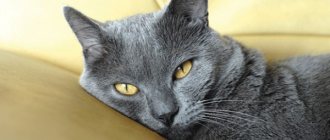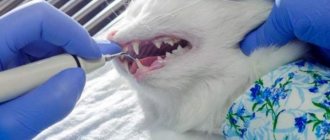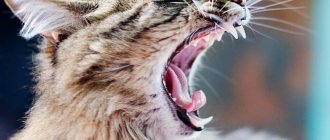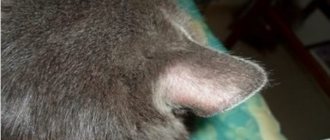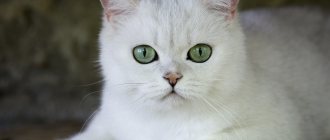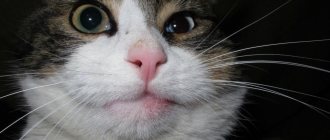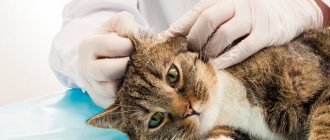Why does pathology develop?
The third eyelid is a fold of the conjunctiva located in the inner corner of the eye, which, in turn, consists of the nictitating membrane - a thin mucous membrane lining the surface of the eyeball and the inside of the eyelid. This membrane moisturizes the cornea with tear fluid and cleans it of debris.
We can say that it resembles a cleaning brush on car windows, performing a similar function. In addition, thanks to the lacrimal gland located at the base of the third eyelid, the cornea is reliably protected from pathogenic microorganisms.
If a cat has a slight covering of the eye with the third eyelid, there is no redness, inflammation, or swelling, then this does not always mean blindness. Perhaps the organ of vision is sunken due to a reduction in fat caused by weight loss, or the cat flu is developing in your pet.
The causes of third eyelid prolapse are varied. The most common ones include:
- Viral, fungal, bacterial infections.
- Pathologies of internal organs - kidneys, liver, gastrointestinal tract.
- Antibiotic therapy.
- Malfunction of the central nervous or hormonal systems.
- Inflammatory processes in the ears.
- Weak ligaments responsible for the activity of the eyelids.
- Consequence of head injuries.
- Worm infestation.
- A foreign body that has entered the eye and that the tear fluid cannot wash off on its own.
- Any form of conjunctivitis.
- Adenoma (benign tumor of the third eyelid).
- Atrophy of the eyeball.
Prolapse of the third eyelid can be diagnosed in absolutely any pet, but representatives of the Persian cat breed are most susceptible to this pathology.
Why is a cat's third eyelid visible and what to do in each case?
Under normal conditions, the inner eyelid does not show. It can only be seen when blinking or until the eyes begin to fully open. Disruptions occur in the animal’s body if the film is stretched over half the eye or completely covers it.
Eye injuries
Eye injury is determined by a veterinarian ophthalmologist during the examination of the cat. Before visiting the clinic, if you suspect injuries, you should rinse the eye area with a weak warm liquid with dissolved furatsilin. Antibiotic drops are usually prescribed for therapy.
Foreign body entering the eye
Foreign bodies are removed by washing the eyes with a cotton swab, previously immersed in warm boiled water. If you cannot remove it, you should immediately consult a doctor so that he can remove the foreign object using special tweezers. After cleansing the eye, you need to put drops into it, which the doctor will prescribe. After this, apply hydrocortisone ointment to the damaged area.
Allergic conjunctivitis
Causes itching, redness of the skin, and coat problems in cats. In this case, it is necessary to identify allergens and get rid of them. To understand what your cat reacts to, you need to keep a record of the foods after which the animal shows signs of allergies. Typically, in this case, the veterinarian prescribes antihistamines, and in especially severe cases, prescribes hormonal therapy.
Read more in the article about conjunctivitis in cats.
Adenoma
It is a benign type of tumor that can appear on the eye of an animal. Causes: infections, injuries, hormonal imbalance. Persians and exotics are most susceptible to this disease. There is no point in leaving the treatment of the tumor to chance, as it can lead to other infections getting into the eyes. In addition, the eyes are poorly hydrated, which causes vision problems.
The adenoma is removed by surgery under local anesthesia, and then drug therapy is prescribed. Sometimes doctors suggest complete removal of the third eyelid, but you need to keep in mind that in this case you will have to constantly moisturize the cat’s eyes with drops, and conjunctivitis will become a chronic disease.
Eversion
Folds in the cartilage of the inner eyelid are called eversion. In appearance, it is similar to an adenoma, but it covers much larger areas of the eyes. The disease is detected during the active growth of kittens, in most cases in purebred animals. Eversion is removed by surgery; independent treatment is impossible.
Parasites
If during the course of the disease the animal becomes lethargic, hardly eats or drinks, and rubs its anus on the carpet, then this is a sure sign of parasite infection. Worms also appear in domestic cats, since the larvae can get into the apartment along with shoes and clothes. The disease can be easily treated at home with the help of medications. It is necessary to carry out anti-parasitic cleaning. The doctor will tell you which remedies can be used in specific cases.
To prevent diseases, animals need to be vaccinated in a timely manner and regularly cleaned of worms. Maintaining health depends on a thorough examination, especially if the cat likes to walk outside.
Flu
In the early stages of the flu, your pet may experience loss of inner eyelids, a possible fever, and pus in the eyes. In this case, doctors recommend frequent rinsing using special drops. It is imperative to treat with flu medications, as this disease can be fatal to your pet. A course of antiviral drugs is prescribed; the use of drugs with local or general action depends on the medical history and diagnosis.
The doctor carries out symptomatic treatment with antipyretic drugs, painkillers, vitamins, and prevention of dehydration is also important. In addition, a rest regime is introduced; the cat needs to be provided with high-calorie food and surrounded with care and attention.
Be sure to read the article about eye diseases in cats.
Other reasons
In addition to the reasons mentioned above, the visibility of the third eyelid indicates reduced immunity. This does not require expensive treatment; sometimes selected vitamins are sufficient. Another reason for the appearance of the third eyelid is stressful situations in the postoperative recovery period.
In some pets, a film on the eyes is visible after castration or sterilization. Before going to the veterinarian, you should observe your pet for several days.
Symptoms
A condition is considered pathological when the third eyelid does not fold and almost completely covers the organ of vision. Experiencing discomfort, the four-legged furry dog begins to rub its face, blink frequently, squint and hide from the irritating light in a secluded place. His eyes turn red, tears flow from them, mucus and pus are released.
Subsequently, a voluminous dense formation is formed in the corners. The temperature often rises.
If one eye is covered with film, then most likely a foreign body has entered it. When there is drooping of the eyelid and narrowing of the pupil, they speak of a pathology of a neurological nature. But if changes are noticed in both eyes, then this is already a serious systemic disease.
Often the third eyelid is the result of a fight or self-scratching and infection entering the wound. Infection leads to the formation of a creeping corneal ulcer or keratitis. The eye becomes cloudy, erosion appears on the surface with white or greenish discharge. This is a very dangerous condition that can be fatal.
Prevention
Preventative measures that help prevent inflammation of the third eyelid do not require special efforts and are aimed at maintaining general health and normal development. This requires:
- balanced diet, following additional recommendations in case of chronic diseases;
- proper care of the pet, its sleeping place and personal items;
- examining the cat after walks;
- carrying out regular deworming (every 3 months) and treatment against ectoparasites;
- annual scheduled vaccinations.
These simple activities will strengthen your pet’s body, so it will be more resistant to all kinds of viruses and bacteria.
You can also contact our site's staff veterinarian, who will respond to them as soon as possible in the comment box below.
Diagnostic methods
Diagnosis is aimed at determining the etiology. To make a diagnosis, a comprehensive examination of the animal is carried out, including the following measures:
- taking anamnesis;
- visual inspection;
- general and biochemical blood tests;
- flushing from the mucous membranes of the eyes;
- ultrasonography;
- PCR diagnostics.
After identifying the cause of the pathological condition (third eyelid in a cat), the veterinarian prescribes appropriate treatment.
Third eyelid in a cat: when treatment is not required
When a mucous membrane covers part of a cat's eye, it is not always a sign of a serious pathological condition .
Be sure to read:
Decoding a blood test in cats: features of the procedure, types, main indicators, norms.
In some cases, you can do without the use of drugs:
- severe weight loss or dehydration;
- recovery after a serious illness;
- decreased immunity;
- mild form of cat flu.
In case of these disorders, you need to carefully monitor the pet’s condition and make sure that he receives a sufficient amount of vitamins and other useful substances from his food. If necessary, you need to regularly remove discharge from the nose and eyes.
Treatment, prognosis
To eliminate infectious pathologies, therapy is practiced, which is based on antiviral and antifungal drugs. Their task is to suppress the development of pathogenic microorganisms.
The animal is also prescribed antipyretics, painkillers, and immunostimulants and vitamin-mineral complexes to strengthen the immune system. Intravenous infusions of pharmacological solutions are advisable.
If prolapse of the third eyelid is associated with an allergic reaction, then the allergen is eliminated and antihistamines are prescribed. For general improvement of the condition, hormonal agents are indicated (in advanced stages).
Eye injuries are treated by applying anesthetic drops and rinsing to remove foreign bodies and debris. Surgery is performed only in severe cases.
If the prolapse of the third eyelid is caused by an adenoma, but the neoplasm does not grow and does not bother the animal, then removal of the benign tumor is not carried out. The operation may have unpleasant consequences, such as dry eye syndrome. As a rule, veterinarians limit themselves to supportive therapy.
Why is third eyelid prolapse dangerous?
Prolapse of the third eyelid in itself is not dangerous, but the diseases of which it is a symptom pose a threat to the cat’s health:
- untimely diagnosis of infectious diseases and delay in their treatment entails aggravation of the disease, the appearance of complications and increases the risk of death of the cat;
- prolapse of the third eyelid due to diseases of the internal organs indicates decompensation of their course and the need for immediate medical intervention;
- allergic diseases in the absence of therapy can result in the development of bronchial asthma, miliary dermatitis, eosinophilic granuloma complex or anaphylactic shock;
- severe helminthic infestations pose an immediate threat to the life of a cat, especially a kitten;
- untreated eye diseases can result in decreased visual acuity, loss of the eye, or the spread of the inflammatory process to the brain and its membranes, which will lead to the death of the cat.
Along with prolapse of the third eyelid, a number of symptoms are observed that allow diagnosing the disease:
- for general diseases: weakness;
- apathy, reluctance to play;
- decreased or lack of appetite;
- nausea, vomiting;
- diarrhea;
- fever;
- weight loss.
- redness of the conjunctiva;
- paresis and paralysis of the limbs;
Photo gallery: third eyelid prolapse
Bilateral prolapse of the third eyelid, which does not cause concern to the cat, occurs with general diseases
Prolapse of the third eyelid on one side is characteristic of eye diseases
Horner's syndrome is manifested by narrowing of the pupil, palpebral fissure, and retraction of the eyeball on the affected side
Lacrimal gland prolapse is characterized by the appearance of a rounded formation in the inner corner of the eye.
How to distinguish prolapse of the third eyelid from prolapse of its gland
Third eyelid tear gland prolapse appears as a pink, round formation in the inner corner of the eye. The cause of the disease can be trauma, as well as the rapid growth of the kitten, leading to rupture of the fragile ligament that fixes the gland to the edge of the orbit. If the prolapse of the gland is not accompanied by a disruption in its blood supply, then it may not cause concern to the cat. If the blood supply is disrupted, swelling of the lacrimal gland occurs, redness of the conjunctiva, and the production of tear fluid is disrupted, which can result in the development of keratoconjunctivitis sicca, a disease that requires lifelong treatment. Treatment of prolapse of the lacrimal gland of the third eyelid is surgical - it is immersed in a pocket from the conjunctiva, which is then sutured. This restores both the function of the lacrimal gland and the function of the third eyelid. It is very important to prevent damage to the third eyelid and lacrimal gland, since their integrity ensures the success of surgical treatment.
Video: lacrimal gland prolapse
What to do at home
The owner must strictly follow the veterinarian’s instructions and provide the pet with good living conditions, rest and adequate nutrition. It is recommended to reduce physical activity.
Under no circumstances should you self-medicate or use medications purchased without consulting a specialist. But phytomineral fertilizer containing ivy bud, plantain, cornflower and calendula can be given without fear.
Remember that if you try to insert a membrane yourself, you can cause irreparable harm to your vision.
During treatment, the cat must rinse its eyes. But for this you should not use the good old folk methods, such as strong tea, but special drugs that relieve inflammation.
A good result is obtained by the Beaphar Oftal eye wash, sold in a veterinary pharmacy. It does an excellent job of cleaning the eyes and fur around them from debris, stimulates self-cleaning and prevents the appearance of tear stains.
After washing the organ of vision, eye drops are used. Among those recommended by veterinarians are Actipol, Levomycetin, Floxal. These drugs are most effective for conjunctivitis and infections. The use of two drugs simultaneously enhances the therapeutic effect. As a rule, experts advise combining Floxal with Korneregel. The course is at least 14 days.
Drops are the most optimal form of the drug. Gel or ointment is much more difficult to apply. The drug is placed under the lower eyelid with the index finger (in no case directly from the tube!).
To ensure that it is evenly distributed, the eye must be massaged. Immediately before the procedure, nails should be trimmed, otherwise the cat may be injured.
The pet will resist manipulation, so it needs to be secured with a blanket or thick towel.
Protrusion (excessive protrusion)
Excessive protrusion of the third eyelid in cats is most often a sign of various diseases of the eyeball, as well as problems in the functioning of the central nervous system.
With protrusion, half of the cat's eye is closed by the nictitating membrane. In addition, the animal experiences lacrimation, blepharospasms, and various changes in the visual organs that are characteristic of a particular disease.
If a furry pet has a third eyelid visible in both eyes, we are talking about double protrusion, which appears with exhaustion, dehydration, pain in both eyes, and bilateral Horner's syndrome.
The causes of excessive protrusion of the inner eyelid are very diverse:
- Various eye pathologies. Protrusion in most diseases of the visual organs (uveitis, ulcers and erosion of the cornea, lens luxation, glaucoma, conjunctivitis) is most often a reaction to pain.
- Neurological disorders that may be part of Horner's syndrome. If, in addition to the loss of the inner eyelid, the cat’s pupil is constricted and the upper eyelid of the same eye is drooping, it is necessary to show the pet to a doctor as soon as possible. Such symptoms indicate damage to the optic nerve due to otitis media, a tumor in the chest or brain.
- Diseases of internal organs. Protrusion in this case is caused, first of all, by poor health, which is associated with diseases of the gastrointestinal tract and other organs, weakness due to infectious diseases, and helminthic infestation.
Treatment for excessive protrusion of the nictitating membrane involves identifying and eliminating the cause that caused this condition.
Third eyelid
This disease, in which a cat's eyes are half closed with a film, is conventionally called the third eyelid. The film that appears on the outside of the eyeball can cover most of its surface. In addition to external signs, the third eyelid also affects the behavior of the cat.
Film on eyes
The pet owner may notice previously uncharacteristic habits:
- Constant blinking and squinting of the eye due to increasing discomfort.
- The cat hides from bright lighting, especially artificial light.
- The pet rubs its muzzle with its paws, most often the eye area.
Additional external signs include increased tearing of the eyes, suppuration and swelling of the mucous membrane, as well as a rapid decline in the pet’s visual acuity. Inaction in the event of such a phenomenon is very dangerous and can lead to complete blindness of the cat.
For old cats, such a symptom is not evidence of pathological processes. However, you cannot do without the help of a veterinarian.
How to help your pet?
When an illness is identified, it is better to immediately identify its cause by seeking the help of an experienced veterinarian.
First, the veterinarian will examine the affected area using an ophthalmoscope and take smears from tear secretions, which will help exclude or confirm the presence of an infectious disease.
If the root of the problem is a disease, the specialist will prescribe anesthetic drops for sore eyes and special ointments. Of course, it is very important to stop the disease itself.
At the same time, the cat's eyes will need to be washed at home to rid them of dirt. If you notice that a kitten or an adult suffers from lacrimation, suppuration and constantly rubs its eyes, then use the following ingredients as a wash:
- boric acid;
- olive oil;
- warm clean water.
Secure the pet well; it is better to carry out the procedure in pairs, wrapping the mustache in a towel. Then gently rinse her eyes using a generously moistened cotton pad or pipette. Afterwards, wipe your pet’s eyes with a clean swab from the outer corner of the eye to the inner.
For suppuration and tearfulness, Lacrimin drops are effective. If creatitis is detected in a tailed creature, then you cannot do without medical help - follow all the doctor’s instructions, this will preserve your pet’s vision.
For cataracts (when, in addition to the formation of a film, the lens becomes cloudy), blockage of the ocular ducts and strabismus, surgical intervention will most likely be required.
It is undesirable for the cat to rub its eyes during therapy, so it is better to use a special veterinary collar.

